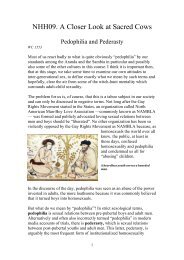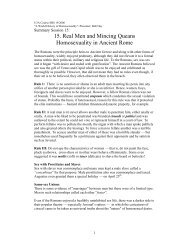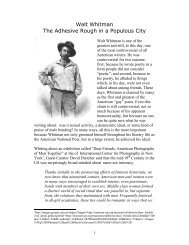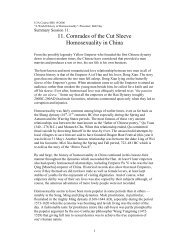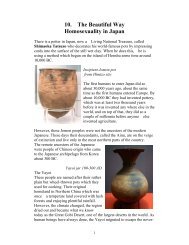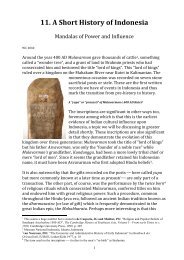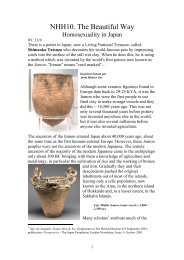7. Boy Wives of the Aranda The Pre-History of ... - BobHay.net
7. Boy Wives of the Aranda The Pre-History of ... - BobHay.net
7. Boy Wives of the Aranda The Pre-History of ... - BobHay.net
You also want an ePaper? Increase the reach of your titles
YUMPU automatically turns print PDFs into web optimized ePapers that Google loves.
humans, which were undoubtedly made from grasses and wood and o<strong>the</strong>r<br />
perishable materials, have not survived. It is not until much fur<strong>the</strong>r down<br />
<strong>the</strong> track that we find stone and bone tools which demonstrate <strong>the</strong><br />
different capacities <strong>of</strong> both Neanderthal and our own Stone Age<br />
ancestors. 2<br />
By <strong>the</strong> time our ancestors came out <strong>of</strong> Africa <strong>the</strong>y were physically<br />
indistinguishable from us. <strong>The</strong>re have been many mutations and<br />
variations since <strong>the</strong>n, <strong>of</strong> course, but for those <strong>of</strong> us <strong>of</strong> European ancestry,<br />
we are no different from our remote ancestors who entered Europe 35,000<br />
to 25,000 years ago. This was a reasonably warm period when <strong>the</strong>re was<br />
sufficient game and o<strong>the</strong>r resources to sustain <strong>the</strong>m in <strong>the</strong>ir hunting,<br />
fishing and ga<strong>the</strong>ring lifestyle.<br />
<strong>The</strong> earliest people to enter Europe from <strong>the</strong> east were what is termed<br />
today <strong>the</strong> Aurignacian, a term referring to a fine flint-knapping<br />
technology which <strong>the</strong>y had developed, <strong>the</strong> remains <strong>of</strong> which tell us all we<br />
know about <strong>the</strong>m. When <strong>the</strong>y entered Europe, probably through Bulgaria<br />
and Hungary, <strong>the</strong>y gradually displaced <strong>the</strong> Neanderthals, driving <strong>the</strong> last<br />
<strong>of</strong> <strong>the</strong>m into westernmost Iberia.<br />
It is about this time that we begin to get our first glimpses <strong>of</strong> human<br />
sexuality. Perhaps <strong>the</strong> best-known representation <strong>of</strong> a human figure is <strong>the</strong><br />
so-called Venus <strong>of</strong> Willendorf , a diminutive figurine <strong>of</strong> a very fat<br />
woman, carved in Oolitic limestone anywhere from 30,000 to 18,000<br />
years ago. Now held in <strong>the</strong> Naturhistorisches Museum, Vienna, this little<br />
lady is only 4.4 inches (11.1 cm) tall. However, she raises more<br />
questions than <strong>the</strong> Mona Lisa: for example, why is she so fat? <strong>The</strong><br />
nomadic hunter/fisher/ga<strong>the</strong>rer lifestyle <strong>of</strong> her day would have made it<br />
pretty near impossible for her to grow obese unless <strong>the</strong>re were women<br />
2 Somewhere along <strong>the</strong> evolutionary trail, our ancestors’ brain size started to grow<br />
larger, reaching its present size about 150,000 years ago. Neanderthal actually ended<br />
up with a larger brain than ours although <strong>the</strong>re is no evidence his species was any<br />
smarter. While <strong>the</strong>re seems to have been no environmental reason why our brains<br />
should have enlarged, many scientists suggest that it did so in order to accommodate<br />
<strong>the</strong> growth <strong>of</strong> culture, including language. It might also have been triggered by our<br />
move to upright stance: standing up we could see much more with our binocular<br />
vision. Possibly this too demanded more computing power. However, standing<br />
upright meant that our noses were fur<strong>the</strong>r from <strong>the</strong> ground and so we could not<br />
depend on scent as much as four-legged animals do when hunting. <strong>The</strong>re is a <strong>the</strong>ory<br />
that humans domesticated dogs whose million-fold sense <strong>of</strong> smell compensated us for<br />
our loss <strong>of</strong> smell while our vision far outstripped that <strong>of</strong> our best friends.<br />
3



